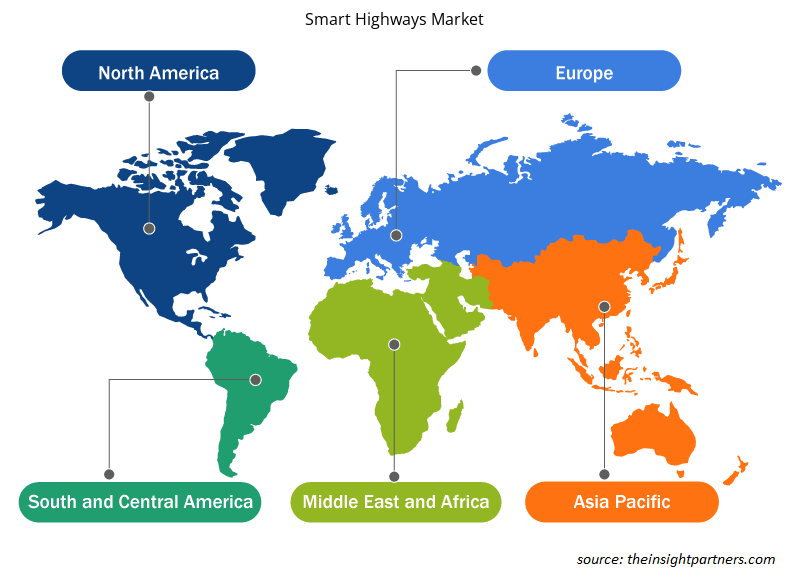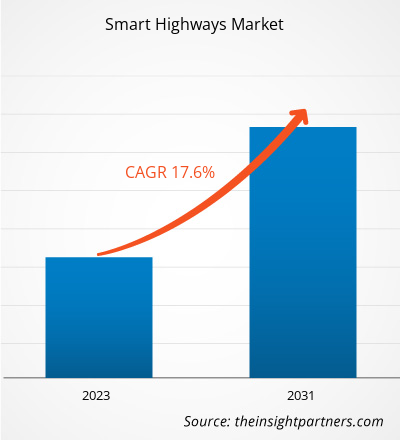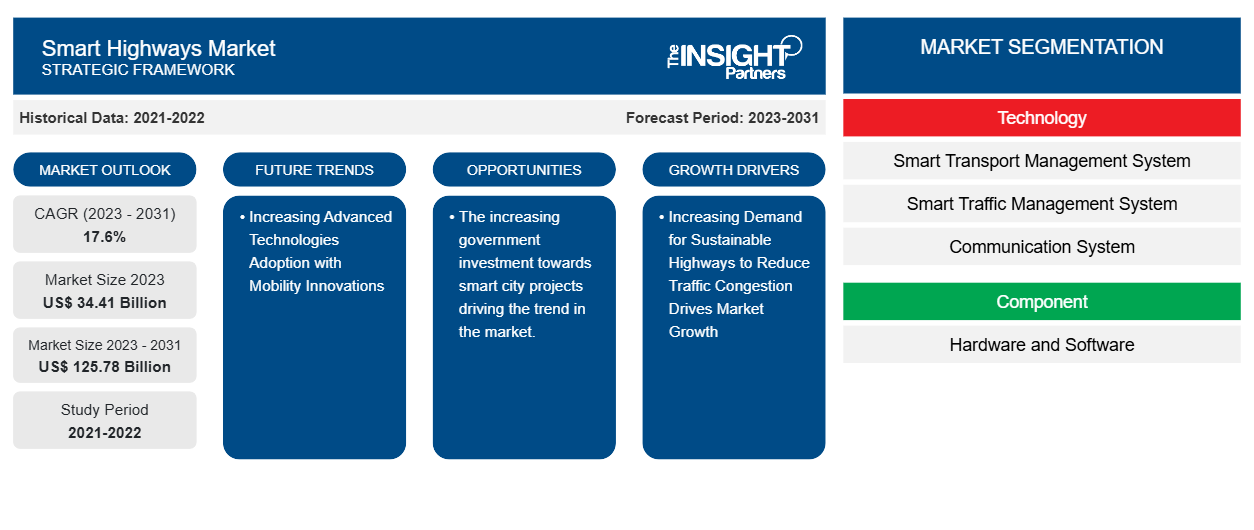스마트 하이웨이 시장 규모는 2023년 344억 1,000만 달러에서 2031년 1,257억 8,000만 달러로 성장할 것으로 예상됩니다. 이 시장은 2023~2031년 동안 17.6%의 CAGR을 기록할 것으로 예상됩니다. 스마트 시티 개발을 위한 정부 이니셔티브가 증가하면서 시장 성장이 촉진되었습니다. 전 세계적으로 스마트 시티 구축을 위한 첨단 기술 채택이 증가하는 것이 시장의 주요 추세입니다.
스마트 하이웨이 시장 분석
인공지능, 사물인터넷, 커넥티드 디바이스와 같은 첨단 기술을 교통 도로에 통합한 스마트 고속도로의 개발이 증가하면서 스마트 고속도로 시장이 성장하고 있습니다. 전 세계적으로 지능형 교통 시스템과 도로 인프라를 지원하기 위해 특히 고속도로를 포함하여 경로를 수정할 계획인 다양한 관리 기관이 있습니다. 예를 들어, 유럽에서는 도로 사용자와 교통 관리자가 도로 활동에 대한 유용한 정보를 조정하고 공유할 수 있도록 스마트 도로를 위해 구축된 Cooperative Intelligent Transport Systems가 있습니다.
스마트 하이웨이 시장 개요
더 나은 연결성을 촉진하기 위해 광범위한 센서 네트워크를 통합한 도시 지역에서 " 스마트 시티 "의 채택과 프로젝트 개발이 증가하면서 시장 성장이 촉진되었습니다. 전 세계의 스마트 시티는 시민의 삶을 더 좋고, 더 효율적이며, 친환경적으로 만들기 위해 상당한 변화를 겪고 있습니다. 스마트 시티 건설과 같은 혁신은 앞으로 몇 년 동안 스마트 고속도로 시장을 상당히 강화할 것으로 예상됩니다.
뉴욕시는 공공 및 민간 부문의 프로젝트를 통해 현재 사물 인터넷과 커넥티드 디바이스가 제공하는 최첨단 기술을 활용하여 디지털 변혁을 겪고 있습니다.
귀하의 요구 사항에 맞게 이 보고서를 사용자 정의하세요
이 보고서의 일부 또는 국가 수준 분석, Excel 데이터 팩을 포함하여 모든 보고서에 대한 사용자 정의를 무료로 받을 수 있으며 신생 기업 및 대학을 위한 훌륭한 혜택과 할인 혜택을 이용할 수 있습니다.
-
이 보고서의 주요 시장 동향을 알아보세요.이 무료 샘플에는 시장 동향부터 추정 및 예측까지 다양한 데이터 분석이 포함됩니다.
스마트 하이웨이 시장 동인 및 기회
교통 체증을 줄이기 위한 지속 가능한 고속도로에 대한 수요 증가로 시장 성장 촉진
지속 가능한 고속도로는 사회적 발전과 경제 성장을 가능하게 하고 환경에 미치는 부정적 영향을 줄입니다. 연방 고속도로 관리국(FHWA)에 따르면 지속 가능한 고속도로는 설계부터 건설, 운영 및 유지 관리에 이르기까지 수명 주기 전반에 걸쳐 평가하고 구현을 고려해야 하는 지속 가능한 개발의 필수적인 부분입니다. 환경 및 천연 자원의 요구를 해결하는 것 외에도 지속 가능한 고속도로는 교통 서비스의 접근성과 안전하고 편안한 도보, 자전거 및 대중 교통 경로에 대한 수요를 충족합니다. 미국의 고속도로 당국은 지능형 교통 시스템(ITS), 재활용, 계획, 환경 연계 및 국가 환경 정책법(NEPA) 요구 사항과 같은 광범위한 이니셔티브를 통해 지속 가능성을 해결하고 있습니다.
건설 및 도로 인프라에 대한 정부 지출 증가는 북미 스마트 하이웨이 시장에 더 많은 기회를 제공할 것입니다. 미국 교통부에 따르면, 미국의 고속도로 및 도로 프로젝트에 대한 공공 건설 지출은 2021년에 955억 달러에 달했습니다. 또한 미국 교통부에 따르면, 스마트 시티 개발을 위한 공공 및 민간 자금에 약 3억 5천만 달러가 투자되었습니다.
모빌리티 혁신을 통한 첨단 기술 도입 증가
애드혹 메시 Wi-Fi 및 셀룰러 차량-모든 것(C-V2X)과 같은 다양한 기술은 운전자에게 신호등의 변화를 알리고 충돌을 피하기 위해 다른 차량과 통신합니다. 디지털 기술의 혁신은 예측 기간 동안 스마트 고속도로 시장 참여자에게 수익성 있는 성장 기회를 제공할 것으로 예상됩니다. 전 세계 정부는 스마트 고속도로 시장 성장을 촉진하기 위해 커넥티드 카 기술에 상당한 투자를 하고 있습니다. 예를 들어, 콜로라도 교통부는 10년 내에 2,500대의 정부 차량에 C-V2X 및 전용 단거리 통신(DSRC) 기술을 장착할 계획입니다. 중국에서는 C-V2X가 광범위한 적용 범위를 제공하기 때문에 정부에서 커넥티드 카의 핵심 지원 수단으로 널리 채택하고 있습니다.
스마트 하이웨이 시장 보고서 세분화 분석
스마트 고속도로 시장 분석에 기여한 주요 부문은 디스크 기술, 구성 요소, 지리입니다.
- 기술에 따라 시장은 스마트 교통 관리 시스템, 스마트 교통 관리 시스템 , 통신 시스템, 모니터링 시스템 등으로 구분됩니다. 이 중 스마트 교통 관리 시스템은 2023년에 가장 큰 점유율을 차지했습니다. 이는 정부 주도로 스마트 시티에 대한 투자가 증가했기 때문입니다.
- 구성 요소에 따라 시장은 하드웨어와 소프트웨어로 나뉩니다. 이 중 하드웨어 세그먼트는 2023년에 더 큰 점유율을 차지합니다. 이는 스마트 시티에 대한 투자가 증가했기 때문입니다.
지역별 스마트 고속도로 시장 점유율 분석
스마트 고속도로 시장 보고서의 지리적 범위는 주로 북미, 아시아 태평양, 유럽, 중동 및 아프리카, 남미의 5개 지역으로 나뉩니다.
북미는 2023년에 가장 큰 점유율을 차지할 것으로 예상됩니다. 이는 주로 교량, 유료 도로, 터널 비용을 지불하기 위한 고속도로 투자 증가 때문입니다. 미국 전역에 이 지역의 도로 운송 및 고속도로 시나리오를 변화시키는 300개 이상의 시설이 있습니다. Toll Miner Data Visualization 도구에 따르면 미국에는 321개 이상의 유료 시설을 운영하는 114개 이상의 운영자가 있습니다. 이는 ETC를 사용하여 무려 6,235마일의 중앙선 도로를 커버합니다. 따라서 시설에서 현금 지불(및 유료 광장)을 없애는 자동 톨링 시스템을 대규모로 도입하면 북미에서 스마트 고속도로의 다른 구성 요소와 기술을 성공적으로 구현할 수 있습니다.
스마트 하이웨이 시장 지역 통찰력
Insight Partners의 분석가들은 예측 기간 동안 스마트 하이웨이 시장에 영향을 미치는 지역적 추세와 요인을 철저히 설명했습니다. 이 섹션에서는 북미, 유럽, 아시아 태평양, 중동 및 아프리카, 남미 및 중미의 스마트 하이웨이 시장 세그먼트와 지리에 대해서도 설명합니다.

- 스마트 고속도로 시장을 위한 지역별 데이터 얻기
스마트 하이웨이 시장 보고서 범위
| 보고서 속성 | 세부 |
|---|---|
| 2023년 시장 규모 | 344억 1천만 달러 |
| 2031년까지 시장 규모 | 1,257억 8,000만 달러 |
| 글로벌 CAGR (2023-2031) | 17.6% |
| 역사적 데이터 | 2021-2022 |
| 예측 기간 | 2023-2031 |
| 다루는 세그먼트 |
기술로
|
| 포함된 지역 및 국가 |
북아메리카
|
| 시장 선도 기업 및 주요 회사 프로필 |
|
스마트 하이웨이 시장 참여자 밀도: 비즈니스 역학에 미치는 영향 이해
스마트 하이웨이 시장 시장은 소비자 선호도의 변화, 기술 발전, 제품의 이점에 대한 인식 증가와 같은 요인으로 인해 최종 사용자 수요가 증가함에 따라 빠르게 성장하고 있습니다. 수요가 증가함에 따라 기업은 제품을 확장하고, 소비자의 요구를 충족하기 위해 혁신하고, 새로운 트렌드를 활용하여 시장 성장을 더욱 촉진하고 있습니다.
시장 참여자 밀도는 특정 시장이나 산업 내에서 운영되는 회사나 기업의 분포를 말합니다. 주어진 시장 공간에 얼마나 많은 경쟁자(시장 참여자)가 존재하는지 그 규모나 전체 시장 가치에 비해 나타냅니다.
스마트 고속도로 시장에서 운영되는 주요 회사는 다음과 같습니다.
- 합류하다
- 주식회사
- 화웨이 테크놀로지스 주식회사
- IBI 그룹
- 시스코
- 캡쉬 트래픽컴 AG
면책 조항 : 위에 나열된 회사는 어떤 특별한 순서에 따라 순위가 매겨지지 않았습니다.

- 스마트 하이웨이 시장 주요 주요 업체 개요를 알아보세요
스마트 하이웨이 시장 뉴스 및 최근 개발
스마트 하이웨이 시장은 1차 및 2차 조사 이후의 질적, 양적 데이터를 수집하여 평가합니다. 여기에는 중요한 기업 간행물, 협회 데이터 및 데이터베이스가 포함됩니다. 스마트 하이웨이 시장의 몇 가지 개발 사항은 다음과 같습니다.
- 인도의 스마트 시티 프로젝트에 따라 두 개의 도로가 개발되었고, 수도는 대중에게 개방되었습니다. 알타라에서 바주타코드와 티코드를 거쳐 첸티타까지 건설된 스마트 고속도로는 2024년 4월 말까지 완공될 예정입니다. 킬리팔람-아타쿨랑가라 도로는 2024년 5월 둘째 주까지 완공되었습니다. (출처: 타임스 오브 인디아-뉴스레터, 2024년 3월)
- 스마트 모빌리티 인프라 관리를 위한 세계적으로 신뢰받는 기술 생태계인 Iteris, Inc.는 오늘 미국 네바다주 카슨 시가 도시의 교차로 감지 센서를 Iteris의 Vantage Apex 하이브리드 센서로 업그레이드하기로 결정했다고 발표했습니다. Vantage Apex는 통합된 인공 지능(AI) 알고리즘을 갖춘 업계 최초의 1080p 고화질(HD) 비디오 및 4차원(4D) 레이더 센서입니다. 차량, 보행자 및 자전거 타는 사람에 대한 최첨단 감지, 추적 및 분류 정확도와 교통 관리 센터 모니터링을 위한 HD 비디오 디스플레이를 제공합니다. (출처: 보도자료, 2024년 4월)
스마트 고속도로 시장 보고서 범위 및 제공물
"스마트 고속도로 시장 규모 및 예측(2021-2031)" 보고서는 아래 영역을 포괄하는 시장에 대한 자세한 분석을 제공합니다.
- 범위에 포함된 모든 주요 시장 세그먼트에 대한 글로벌, 지역 및 국가 수준의 스마트 고속도로 시장 규모 및 예측
- 스마트 고속도로 시장 동향과 운전자, 제한 장치, 주요 기회와 같은 시장 역학
- 자세한 PEST 및 SWOT 분석
- 주요 시장 동향, 글로벌 및 지역 프레임워크, 주요 업체, 규정 및 최근 시장 개발 사항을 포괄하는 스마트 고속도로 시장 분석
- 시장 집중도, 히트맵 분석, 유명 업체 및 스마트 고속도로 시장의 최근 개발 사항을 포함하는 산업 환경 및 경쟁 분석
- 자세한 회사 프로필
- 과거 분석(2년), 기준 연도, CAGR을 포함한 예측(7년)
- PEST 및 SWOT 분석
- 시장 규모 가치/거래량 - 글로벌, 지역, 국가
- 산업 및 경쟁 환경
- Excel 데이터세트
최근 보고서
사용 후기
구매 이유
- 정보에 기반한 의사 결정
- 시장 역학 이해
- 경쟁 분석
- 고객 인사이트
- 시장 예측
- 위험 완화
- 전략 기획
- 투자 타당성 분석
- 신흥 시장 파악
- 마케팅 전략 강화
- 운영 효율성 향상
- 규제 동향에 발맞춰 대응























 무료 샘플 받기 - 스마트 고속도로 시장
무료 샘플 받기 - 스마트 고속도로 시장